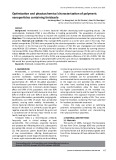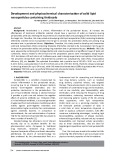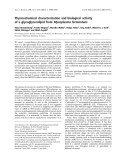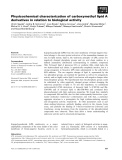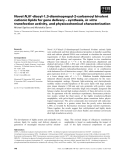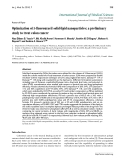
88
Journal of Medicine and Pharmacy, Volume 13, No.04, June-2023
Development and physicochemical characterization of solid lipid
nanoparticles containing tinidazole
Ho Hoang Nhan1*, Le Thi Thanh Ngoc1, Le Hoang Hao1, Tran Thi Kieu Ny1, Dao Anh Tuan1
(1) Faculty of Pharmacy, Hue University of Medicine and Pharmacy, Hue University
Abstract
Background: Periodontitis is a chronic inflammation of the periodontal tissues. To increase the
effectiveness of treatment, antibiotics selected should have a spectrum of action on bacteria causing
periodontitis, while also meeting the requirements of cell penetration and prolonging of the retention time at
the target site. Therefore, this study aimed at developing solid lipid nanoparticles (SLNs) containing tinidazole
(TNZ-SLNs) oriented to be incorporated into the gel to increase the penetration ability and prolong drug
retention time in periodontal tissues. Objectives: Therefore, this study aimed to develop and characterize
solid lipid nanoparticles (SLNs) containing tinidazole (TNZ-SLNs) oriented to be incorporated into the gel to
increase the penetration ability and prolong drug retention time in periodontal tissues. Methods: TNZ-SLNs
were prepared by combining hot homogenization and solvent evaporation using different types of lipids and
surfactants. Factors related to the formula and the preparation process were investigated, Design Expert
12.0, FormRules v2.0 and InForm v3.1 software were used to design experiments and optimize the formula.
The prepared nanoparticles were characterized by particle size, polydispersity index (PDI), encapsulation
efficiency (EE), etc. Results: The optimized formulation had a particle size of 197.60 ± 19.67 nm, a PDI of
0.247 ± 0.011, a zeta potential of -15.79 ± 0.75mV and an EE of 37.96 ± 0.91%. TNZ-SLNs showed prolonged
in vitro drug release (for up to 24 hours), while TNZ material achieved about 100% drug release after 4 hours.
Conclusion: TNZ-SLNs were successfully fabricated and physicochemically characterized.
Keywords: Tinidazole, solid lipid nanoparticles, periodontitis.
Corresponding author: Ho Hoang Nhan, email: hhnhan@huemed-univ.edu.vn
Recieved: 22/2/2023; Accepted: 4/5/2023; Published: 10/6/2023
1. BACKGROUND
Periodontitis is a condition characterized by
chronic inflammation in the periodontal tissues,
occurring due to an imbalance between bacteria
(mainly Gram-negative anaerobes) and the
protective mechanisms in the periodontium. The
use of local antibiotic therapy is advised because
it provides a quick cure and reduces the negative
effects of systemic antibiotic use. Tinidazole (TNZ),
a 5-nitroimidazole antibiotic, is a second-generation
drug derived from metronidazole. It exhibits excellent
activity against gram-negative anaerobes and
demonstrates higher sensitivity than metronidazole
against anaerobic bacteria. In comparison to
metronidazole, the oral administration of systemic
TNZ for the treatment of periodontitis has proved to
have a number of benefits [1].
Nanotechnology has attracted a lot of interest
recently due to its excellent benefits for the
pharmaceutical sector. Compared to traditional
drug molecules, nanosized drug molecules
improve therapeutic efficacy and boost absorption.
Additionally, the advent of nanotechnology has
been embraced by the pharmaceutical field as a
fundamental tool for researching and developing
new drug delivery systems, such as localized
drug delivery, sustained release, and targeted
therapy. These advancements aim to overcome the
limitations of conventional drugs and formulations,
such as low solubility, poor bioavailability, wide
distribution, while reducing the frequency of drug
administration, enhancing treatment adherence,
and improving patients’ quality of life [2]. Among
these approaches, solid lipid nanoparticles
(SLNs) stand out as a promising direction. SLNs
are nanosized particles composed of lipids in
a solid state at room temperature dispersed in
water or aqueous surfactant solutions. SLNs offer
numerous outstanding advantages, including high
biocompatibility, avoidance of allergic reactions,
enhanced drug solubility, reduced toxicity, increased
bioavailability, and improved cellular penetration.
Due to these characteristics, they are ideal for
targeted gel compositions used to treat periodontitis
[2].
Thus, this study was aimed to formulate the SLNs
containing TNZ (TNZ-SLNs) as well as evaluate some
physico-chemical properties of the formulations.







